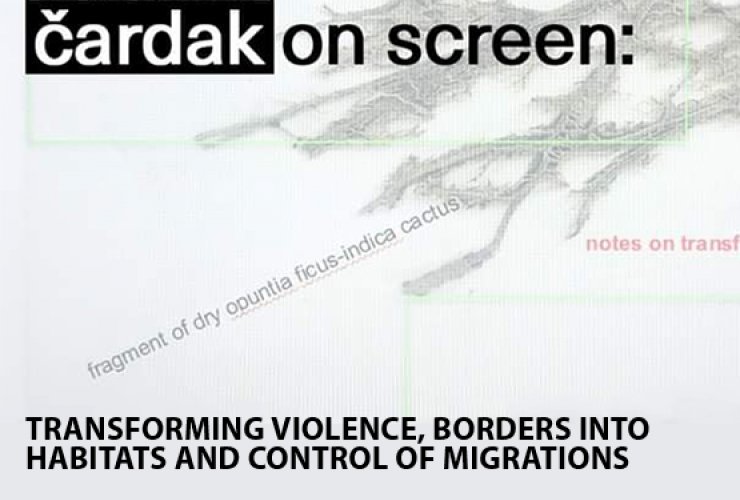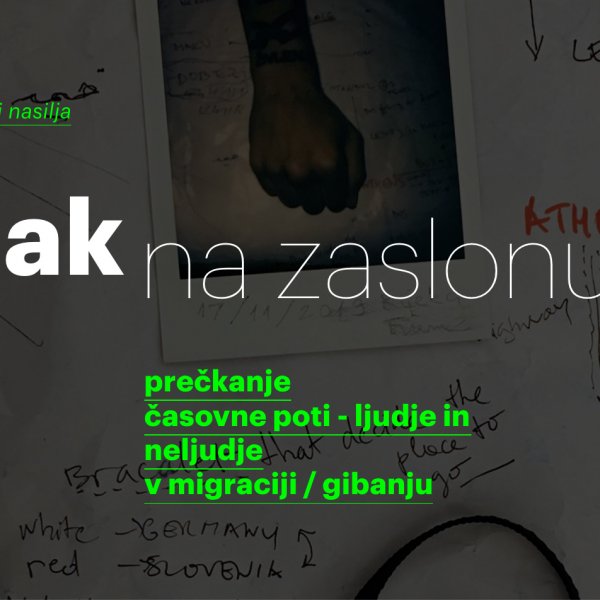Un-war Space Lab:
Presentation on "čardak on screen" project
28. 05. 2020
You are kindly invited to join us for a launch of an on-line project “čardak on screen”, conceived and developed by collective Un-war Space Lab consisting of Armina Pilav, Karla Crnčević and Servet Cihangiroglu. The on-line live event assumes an introduction of the conceptual frameworks, research methodologies and its current form of presentation as an on-going on-line archive of film essays, soundscapes, stories, conversations, archival material, photographs and texts.
website: čardak/çardak on screen
The project at this unfolds as an online presentation and archive of the material gathered during the program of Touring residencies in the scope of the Risk Change project taking place between November 2019 and March 2020.
National border systems and border infrastructures are differently organized and represented throughout the world. These systems and infrastructure define, influence, manipulate, surveil as well as destroy people’s lives as they also equally violently inscribe histories in the surrounding landscapes. These histories are, of course, created and at the same time concealed by the same (institutionalized) structures that silence different voices at the margins of our geopolitical spaces and societies in general. Un-war Space Lab collective created particular transitional spaces in the form of site-specific meetings under the name čardak/çardak. These spaces included many agents – humans, non-humans and took place in natural or build landscapes. Project “čardak on screen” thus inhabits a digital space where individuals on-the-move bring forward different levels of urgencies related to migrations. Through time they collectively created this space of learning, unlearning and sharing knowledges and experiences.
“In our view, čardak/çardak spatial and material characteristics are subject to changes, according to the different territories, pandemic outbreaks, biopolitics, individual perception and imagination of belonging to the given by birth state or nation. čardak/çardak was an impermanent space for our way of living an impermanent life during the residency traveling. Our being together in čardak/çardak and meeting the others was impermanent, short and characterized with a long list of opposing conditions as being: safe/unsafe, legal/illegal, inside/outside the migrants' experiences, making/unmaking images of migration, between open/closed meetings, political/unpolitical, in the noise/silence with ourselves or others. We were collecting site-specific narratives of events and conditions when the humans have had and still need to move due to the wars and other natural or man-made disasters, lack of employment in their own country, resources as a consequence of the century’s long colonization processes and extractions of natural resources in different parts of the Earth.
Forming our own čardak/çardak, in Croatia, Serbia, Malta and even this one on the screen with all visitors is an attempt to form the impermanent society. The interrelated and de-centralized group aware of transitional geographies while inhabiting them, opposing the fascist order of belonging to the nation-state constructs and continuous reproduction of violence and war with all possible means shifting between weapons, military industry, migration laws, capitalism and patriarchal abuse of nature and humans."
Un-war Space Lab is led by Armina Pilav, a researcher in ecologies of violent spatial transformations and lecturer at the Department of Landscape Architecture, The University of Sheffield. She received the Marie Curie Fellowship for her Un-war Space research (2016-2018) developed at the Faculty of Architecture and Built Environment at TU Delft. Karla Crnčević holds a MA in film dramaturgy and is based in Rijeka and Zagreb. She is one of founders of the Unseen, experimental hybrid festival held in Cavtat, started in 2017. Her work explores politics of images and sound through various formats and working conditions. Servet Cihangiroglu’s work focuses on ephemeral documenting of the contemporary conditions of war in Turkey while exploring his own experience and living in complex and conflict environments. In his practice, he employs various bodily interactions and different physical materials in performative relationships, photography, video, urban and domestic spaces.
_____
Production: Association for contemporary art X-OP
The project is part of the Risk Change (2016—2020) project co-financed by the Creative Europe program of the European Union. The project is co-financed by the Ministry of Public Administration of Republic of Slovenia.








